 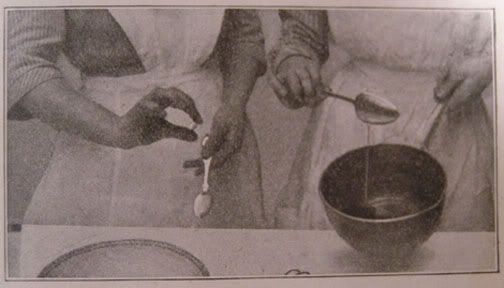 I’m really having fun going through my grandmother’s “Domestic Science Books I and II” book. Having been published in 1914, you can imagine the photos of women in their sleeved, long dresses and taylored, floor-length, white aprons, primly tied at tiny waists. I feel very happy to see that my short, work-worn fingernails look exactly like theirs. Evidently, women, back then, didn’t worry about French tips or painted designs on their fingernails, either. At the beginning of book II of this wonderful home living manual, I came across the following poem, by Owen Meredith. It is so ridiculous, I have to post it. Obviously, this Owen guy would have benefitted from today’s Overeater’s Anonymous. He seems to have been so focused on eating that all else was trivial to him! You be the judge: O hour of all hours, the most bless’d upon earth, Blessed hour of our dinners! * We may live without poetry, music, and art, We may live without conscience, and live without heart; We may live without friends; we may live without books; But civilized man cannot live without cooks. He may live without books – what is knowledge but grieving? He may live without hope – what is hope but deceiving? He may live without love – what is passion but pining? But where is the man that can live without dining? – Owen Meredith Makes you hungry, huh? Well, I’ll solve that problem and share another lesson in recipe from days gone by, which would be easy to cook on your wood cook stove! You can pretend! I will be giving the recipe for their dumplings, which are the type that are fluffy and soft. We southerners like flat dumplings or oval ones that are more like noodle dough. And so, while I’ll give you the recipe the book suggests, I’ll show you the pictures and recipe for the dumplings that I make. And of course, at the end, just as in the book, I’ll post those rules for table manners ala 1914. So stoke up the fire…. 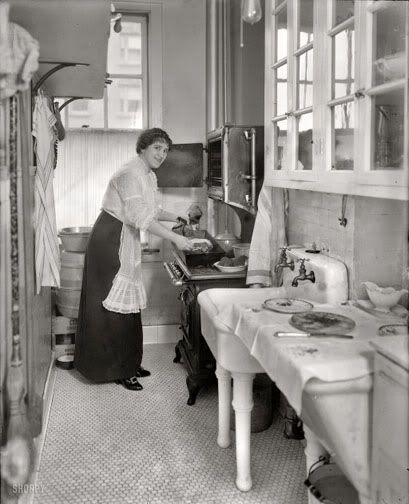 3 lbs beef – preferably round roast 1 tblsp butter 2 tblsp flour 2 onions sliced 1 carrot 4 potatoes water or beef stock salt and pepper 1 turnip (optional) Dumplings 2 cups flour 4 tsp baking powder 1 tsp salt 3/4 cup water or milk Sift the dry ingredients together; add the liquid gradually. Drop by the spoonful upon the stew and cook until done. 1 cup all-purpose flour 1 egg 1 tsp baking powder 1/4 cup water or milk 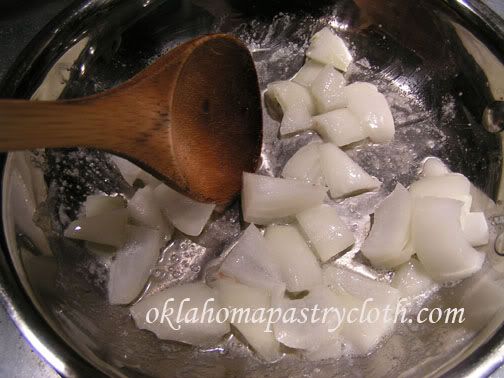 Cut the roast into 1″ cubes and toss meat in flour. I used my canned rump roast (what can I say? Rump roast was on sale, cheap!) and cubed that. Sauté onions in butter and add beef to brown. 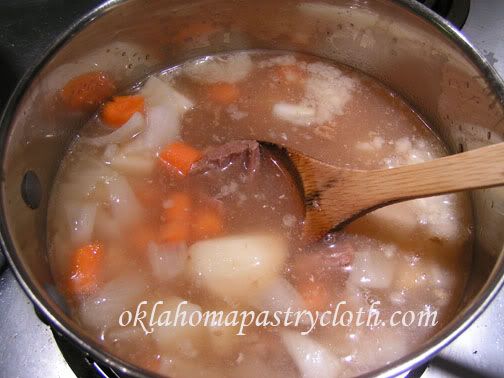 Add water or beef stock (I used stock) and simmer for at least an hour to an hour and a half until meat is tender. Add chopped carrots, potatoes and chopped turnip (optional) and cook 45 minutes longer. 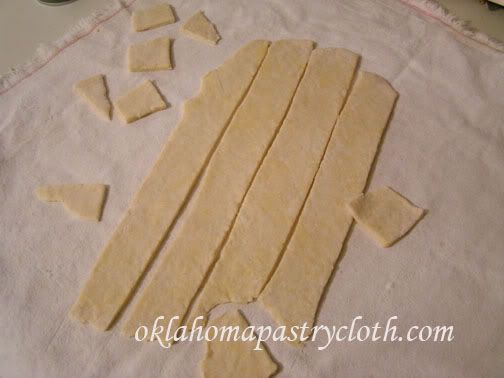 Mix ingredients together for dumplings, using just enough water to form a dough ball. Roll out onto your Oklahoma Pastry Cloth™ and slice in 1″ strips. Slice strips across to form 1″ squares. 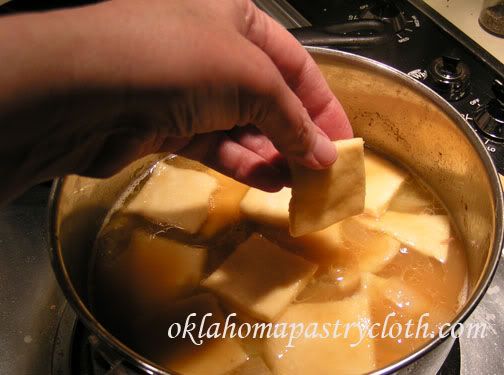 Bring stew to a boil and place dumplings on top of broth. 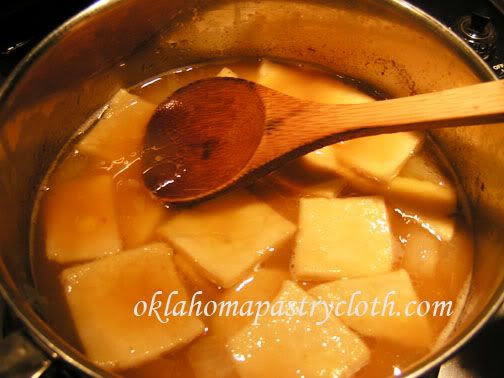 With spoon, gently press dumplings into broth to cover. Simmer for 20 minutes until tender. 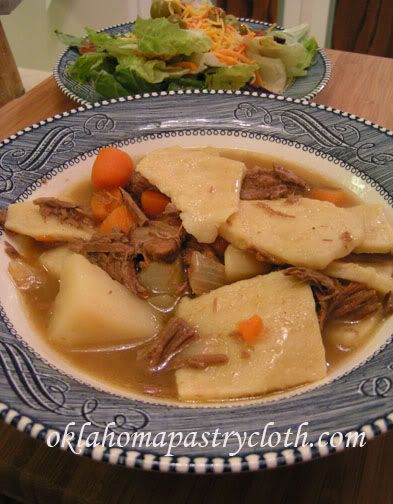 Serve with salad and cornbread or fresh bread and dig in. It’s simple! Table manners: Do not hold the knife and fork upright on the table. The knife and fork when used for cutting should be held with the fork, tines down, in the left hand and the knife in the right hand, the handles in the hollows of the hands. Do not open the mouth to receive food until the food reaches the mouth. Always eat or sip from the side of the spoon. The napkin should never be tucked in the collar.  |
|
|
Oklahoma Pastry Cloth™ Company on Facebook
|
|
 |
|
|
Posts Tagged ‘Vintage Cooking’
Vintage Cooking Pt 2
Thursday, January 12th, 2012
Vintage Cooking Pt 1
Monday, January 9th, 2012
 Some call it “pretending” but I like to call it “supposin’ ” when, every so often, I whisk myself back (in my mind of course) to the late 1800’s and early 1900’s wondering what it would be like to do back then, what I am doing at that moment. For example, in 1992 I broke my leg and ankle in five places and as I lay on the couch with leg encased in plaster of Paris, elevated and throbbing, I immersed myself in a book entitled ‘And Ladies of the Club’. Transported back into the time of the Civil War and then the Victorian age, I read that my situation would have been quite dire indeed. Instead of a cast, I would have had my leg cut off and could have died of gangrene. Lovely. Made me appreciate 1992 all the more! But I do see the good of those eras with the slower way of life and simpler way of doing things. It is an encouragement for us to slow down and simplify as well.  Awhile back, I posted an account about my parents’ life-changing move to a retirement community. The process was emotional for all of us because of the sale of their home and their move to another state. But going through all of the boxes holding their nearly 62 years of marriage, passed on to each of us four girls and our children, was bittersweet indeed. One of my boxes held a number of very old cookbooks. My parents know me well! Some of these books are just amazing and precious. The oldest one and truly my most precious of cookbooks, is the 1914 first edition, high school textbook for Austin’s Domestic Science (we called it Home Ec) inscribed with the perfect penmanship of my Grandmother Johnson, then Margaret Allen, Class IC – my mother’s mother. Recipes recorded by her with an inkwell and pen, obviously lessons from class, cover pages nestled between tiny print of early 1900’s etiquette, rules, ingredients and recipe lessons. The book is a treasure, as are some of the others, and I thought that I would do a series of posts using a few of the vintage recipes, instructions and lessons in etiquette. Skimming the book, my eyes fell on the title, “Hamburg Steak”, and immediately, I decided to make that my first endeavor. I’ll give you three guesses what is Hamburg Steak! The recipe was brought to America by German immigrants where Hamburg Steak was a meal of the poorer classes. It wasn’t until 1916, two years after this textbook was published, that the Hamburger Bun was introduced by a fry cook named Walter Anderson, who co-founded White Castle in 1921. I have to tell you that I did not think this recipe was going to be all that great, but Mr. Fix-It loved it and asked for the leftovers the next day! 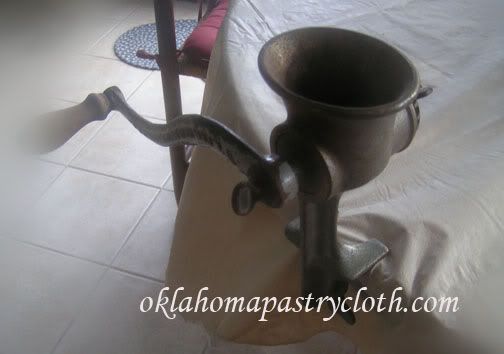 I had to consider the fact that most people did not buy freshly ground meat in 1914 and so the instructions in the recipe to purchase round steak, to remove the bone and gristle and to cube and grind in the hand grinder should be no surprise. I, however, DO buy ground meat today and so I skipped that process even though I have a hand grinder, have capable shoulders and used to grind meat as a butcher’s assistant! There is only so much “supposin’ ” I’m willing to initiate these days. Anyway, I wonder if they called it Ground Round back then. I was struck that most of the beef recipes in the book called for either round steak, ground, or round roast, sliced or whole. Evidently, that was the cut of meat most popular. It totally explains to me why mother, when first married and with very little money, stunned my father when she brought home the expensive ground round from the store. She says that her mother only served ground round, and never any of the cheaper ground meats, so she did not know there were any other types of ground meat. Obviously, Grandmother had learned well about her meats in Class IC of Domestic Science! So fire up your 1914 wood stoves (or if you were rich, the newly introduced fancy gas stove) and get out your cast iron skillet. The recipe is simple and really yummy. Be sure and note the etiquette rule about your after dinner coffee or tea at the end. 1 tablespoon finely chopped onion 1/2 teaspoon salt 1 egg dash of pepper 1 lb round steak, boned, cut into cubes and run through a meat grinder (1 lb ground round y’all) Gravy: 2 tbsp butter 2 tbsp flour 1 cup beef broth  Add finely chopped onions to ground meat 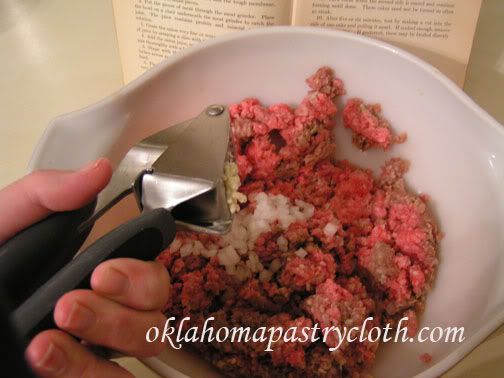 The recipe did not call for garlic, but I have to have my garlic and I think that it made a huge addition. Either chop or press your galic clove. 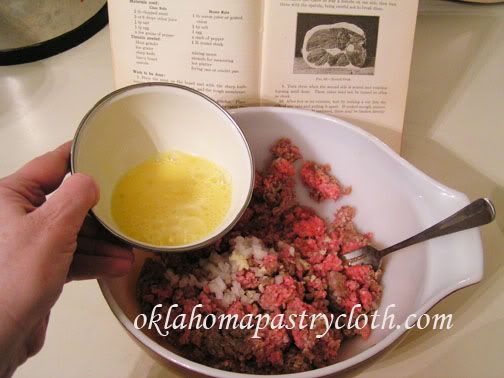 Add beaten egg 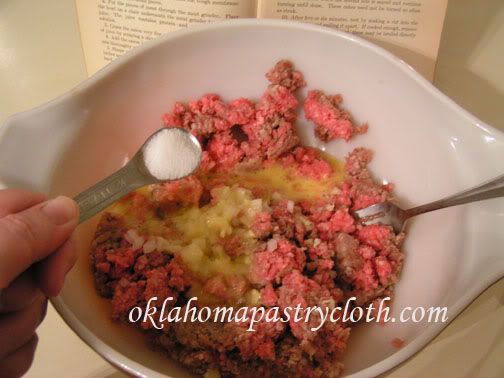 Add salt 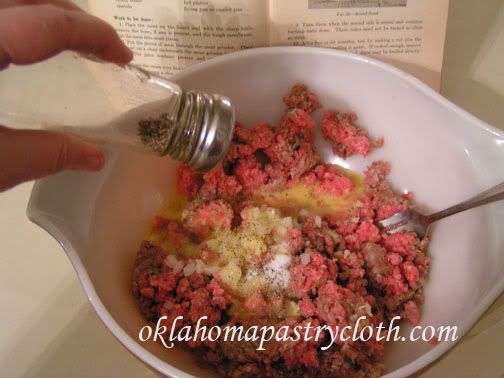 And pepper 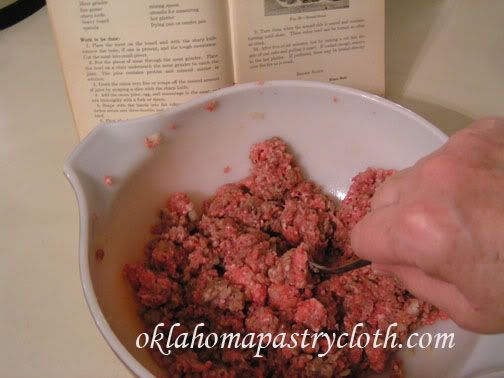 Mix ingredients until well incorporated 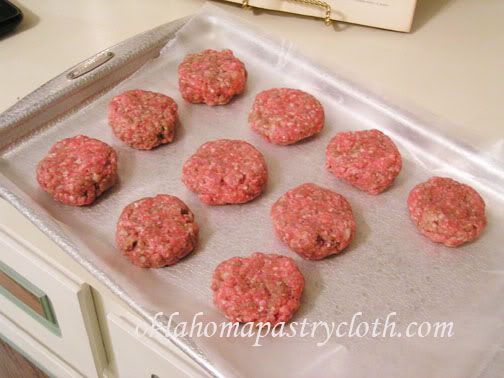 The recipe called to form into patties 1 1/2″ in diameter and 3/4″ thick, but I think mine were more 2 1/2″ diameter and 3/4″ thick. 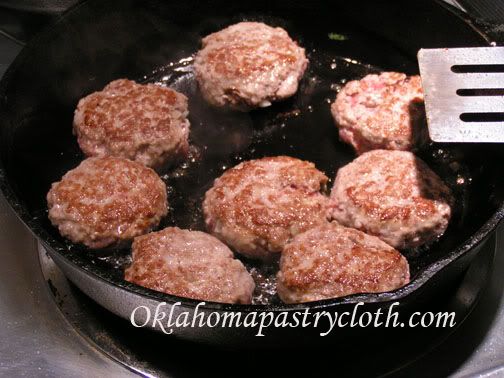 Add tblsp of butter to a heavy skillet on high heat and spread across the surface to oil. Place patties into the skillet to sear for about 30 seconds. Turn and sear on the other side and reduce heat to medium. Continue to turn patties until cooked all the way through. Do not press them or pierce them because the juices are trapped inside and make the patties tender and tasty. 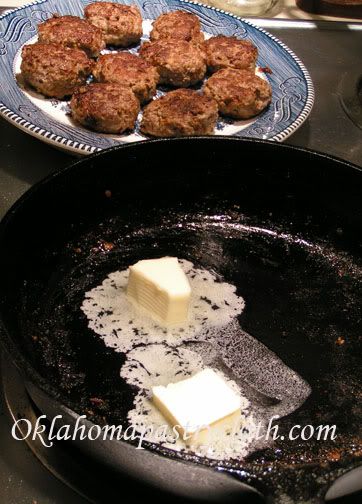 Remove patties to a warming plate to keep warm. Wipe skillet lightly to remove beef fat and add two tblsps butter to melt on medium heat. 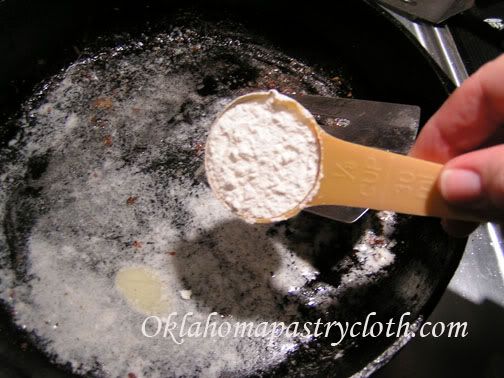 Add flour 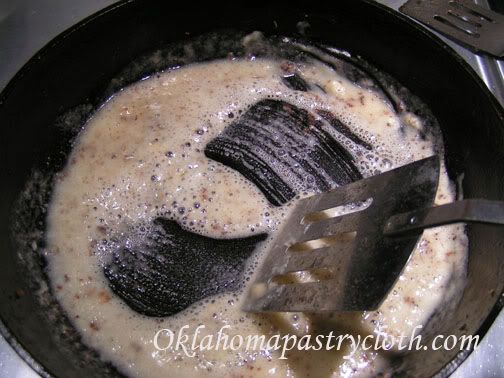 and stir quickly to form a ‘roue’ 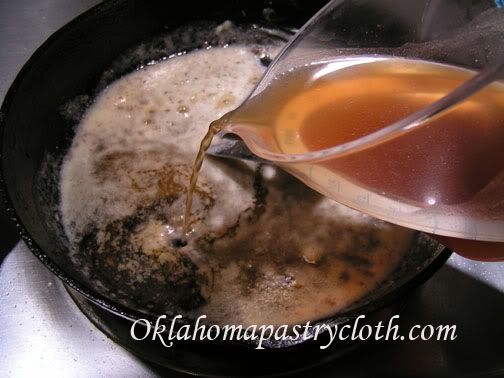 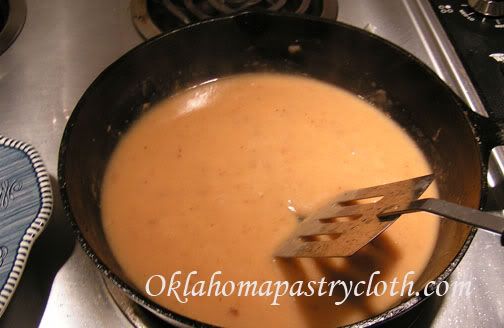 Pour in beef stock and stir to form a gravy. 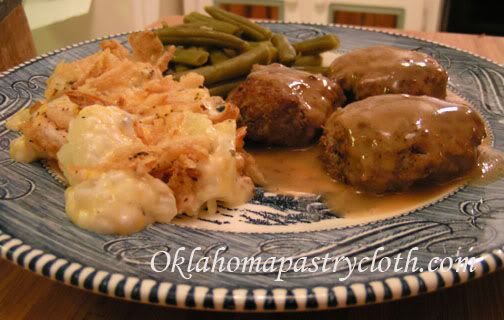 Served with au gratin potatoes, green beans and fresh bread, this meal made Mr. Fix-It very happy! The following is an etiquette lesson from the book that all should know for sure!!  Austin’s Domestic Science Book One and Two, page 170: “At a formal dinner, very strong coffee is made and served without cream, but with or without sugar as the individual prefers. Such coffee is called café noir, or black coffee. It is served in very small coffee cups, or after-dinner coffee cups. When cream and sugar are served with coffee, many think the flavor of the coffee is improved if they are placed in the cup before the coffee is poured in. TABLE MANNERS: Coffee, tea and cocoa should be drunk from the cup. The spoon is used to stir coffee or tea and sip it in order to ascertain if the flavor is right, but should not be otherwise used with coffee or tea. It seems unnecessary to state that these beverages are never to be drunk from the saucer.”  |
|
|
Oklahoma Pastry Cloth™ Company on Facebook
|
|
 |
|
|

 Homestead Revival
Homestead Revival Paratus Familia
Paratus Familia Rural Revolution
Rural Revolution